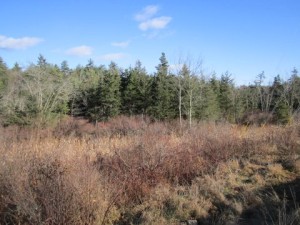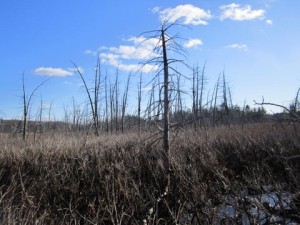
The evergreens in the foreground are healthy Atlantic white cedars. The bushes with red twigs are high bush blueberries. The ground cover beneath them includes peat moss, cranberries and other bog plants.
Stream Team photo
When driving north on Route 114 in Middleton you’ll pass Emerson Bog, a bushy public water supply on the your left. Starting a half century or so ago the boards in the spillway of the dam on Lake Street that flooded it were kept up all year. Before that they had been removed in the summer to let haymakers and cranberry pickers out on the bog. Stream Teamer, Francis Masse, remembers picking there. The resulting higher water covering over 150 acres of Emerson Bog year round killed many trees. Several acres of a dense stand of Atlantic White Cedars, Chamaecyparis Thyoides, were drowned. This species when alive is the exclusive home of the Hessel’s Hairstreak butterfly. Many of the cedars’ bleached corpses still stand above the flooded bog. In a wetland just across the highway, a small grove of cedars is still very much alive. Water loving cedars, or perhaps more correctly cypresses, grow in acidic peat moss swamps. A couple of their woody neighbors are High Bush Blueberries and Red Maples. We’ve picked cranberries and found insect catching sundew and pitcher plants nearby in open areas of the same swamp.
The loss of cedars in Emerson Bog was caused by a manmade dam. The two other large drowned cedar stands in Middleton are the victims of beaver dams. Twelve acres of cedars just west and southeast of Pond Meadow Pond in the northernmost tip of town near North Andover and Boxford are lost to us and the Hessel’s Hairstreaks. The beaver dam that killed them was built in 1999. Not far west of Middleton Center, a third mile down Lake Street from the Fire House, is a more recent kill. That dense cedar stand encircling Aunt Bett’s Pond died in about 2005. Beavers plugged large drainpipes carrying water away from the large swamp. Before the pipes were blocked excess water flowed to Emerson Brook under Forest Street and to Middleton Pond under Lake Street. These cedars like water but they can’t take too much year around.
A couple weeks ago, a friend gave an old Closeteer a hand tool in common use long ago. It is a handsome brand new froe. Friend Carl Close, a blacksmith among many other things, made it from scratch. Carl is known to friends as a craftsman-artist who can make just about anything well. A froe is a heavy-long-straight blade with a thick back and sharp edge. On one end is an oak handle perpendicular to the blade. The blade is placed across the end grain of a short log. The back is then pounded with a heavy club made of tough American Elm. When well inserted, the blade is twisted and the log splits. A froe is simply a long bladed wedge. Froes were once used to split shingles from short sections of straight grained Atlantic White Cedar, Northern White Cedar (Arborvitae) and White Pine. These light woods weather well. Froe made shingles don’t taper end to end so maybe they should be called shakes as they are out west. Most colonists used cheaper thatch for roofs. The wealthier shifted to shingles. Early fire prevention laws eventually had everyone using safer shingles. Most stands of Atlantic White Cedar all along the coastal plains from Mississippi to southern Maine were soon gone. Then sometime in the 19th century boat polers or others poking around in murky swamp waters hit upon submerged logs. A wood mining industry began; one of the greatest was just west of the Hudson River and Jersey City in the Hackensack marshes. The sought after treasures were fallen cedar logs long ago covered by sediment and each other. In some places they were found in strata to depths of 100 feet.1 The decay resistant wood was further protected by the acidity of the peaty swamp water. They were pickled.

These corpses of Atlantic white cedars have been standing in Emerson Bog for a half century. Water raised in this large reservoir killed them. Beneath the cedar trunks are thick stands of water-loving button bushes. Sunday’s high wind felled a tree near the photographer. More than half of the slowly rotting trunks have fallen.
Stream Team photo
Let’s return to our local groves of swamp cedars dead and alive. They could probably be mined too; we hope they never are. The “beaver meadows” that have replaced them are rich wildlife habitat. Before the beavers returned here in 1996 the old Closeteer used to visit Aunt Bett’s bog with his sons. They usually did so on thick ice but also in dry late summers when lower water allowed. He too often tells us of his first visit alone to the dense stand around perfectly round Aunt Bett’s Pond. It was summer and the water was only ankle deep between hummocks. The surprising gloom in midday much surprised him. A canopy of meshing cedar tops caught the light from the sun directly above. As his eyes adjusted, a great clutter of fallen and leaning logs became apparent; for every straight-live-standing cedar there seemed to be one down or nearly so crisscrossing his intended way. The wet ground was not of solid soil but rather soft peat on bumps due to sunken logs and shallow roots. The shallow roots may explain the many fallen and tipped trees. The survivors of wind and heavy ice, tops touching, must support each other. It was slow going through the grove which was unlike anything he had experienced in 60 years of bush whacking. The interesting difference kept him half walking, stumbling, and climbing on. A few years later in an attempted beeline across another larger cedar grove around Pond Meadow Pond in late fall he started too late in the afternoon. The dark of day joined that in the shaded bog. As sunset approached he became alarmed even though there was less than half-a-mile to go. His slow stumbling pace might end in pitch blackness. There was no turning back. Run-a-way prisoners escaping Southern road gangs into cypress swamps came to mind. Alas, there were no trackers with dogs to bring him back. The old Closeteer obviously made it out so we will probably hear the story again.
Last Sunday in wind chills down in the teens, he visited the only live grove left in Middleton, the small one mentioned just off Route 114. The dense evergreen foliage of the young cedars on the edge shielded him from the wind. He sat on a peat upholstered hummock and pondered upon the vast groves of large trees before the need for shingles and many other uses, and worried about the beavers he so otherwise admires and the endangered local Hessel’s Hairstreaks.
Check out that grove, it is only a few tree lengths off the road. If you nap on the soft moss and later awake in the dark don’t fret. Walk toward the sounds of traffic.
1 p.73 Peattie, Donald Culross. A Natural History of Trees of Eastern and Central North America
—————————————————————————————————–
*Danvers Water Filtration Plant, Lake Street, Middleton is the source for actual precipitation data thru Oct. Normals data is from the National Climatic Data Center.
**Updated Nov precipitation data is from MST gage
THE WATER CLOSET is provided by the Middleton Stream Team: www.middletonstreamteam.org or <MSTMiddletonMA@gmail.com>
